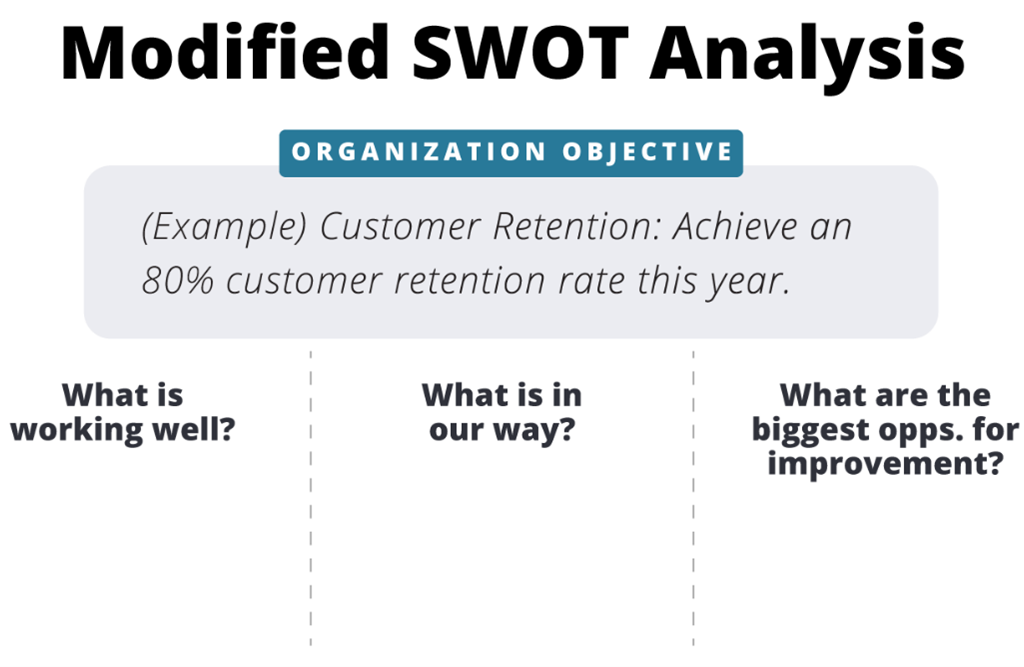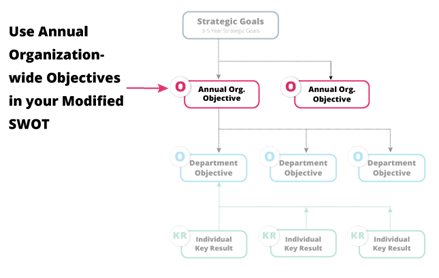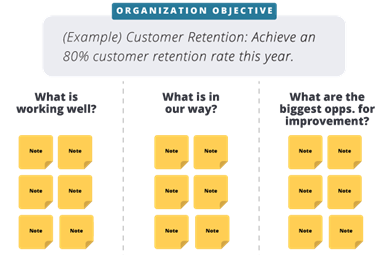We get it. Doing a SWOT analysis over and over every year can be a drain on your planning team.
But, as you review your strategic plan and provide a refresh, it’s important to assess your current state, what’s working, what isn’t, and where there are opportunities to improve.
So, we’ve created the Modified SWOT Analysis as an exercise to review and refresh your plan without completely redoing your SWOT every year.
Refresher: SWOT Overview
SWOT stands for Strengths, Weaknesses, Opportunities, and Threats. This tool creates a synthesized view of your current state, objectively reviewing what your organization is and isn’t doing well and where opportunities and threats lie in your competitive environment.
You can see our in-depth overview of SWOT here, and how to do a SWOT in 5 steps here.
What is a Modified SWOT Analysis?
A modified SWOT isn’t a SWOT at all if we’re being completely honest.
Revisiting your traditional SWOT grid over and over can become a drag year after year. To freshen this activity up and make it more valuable and applicable, we’ve created a way to shortcut reviewing your current state and helping drive the refresh of your strategic plan.
The first key difference is that a modified SWOT analysis looks at individual strategic objectives in your current plan instead of your organization’s entire current state.
Get the Free Guide and Canvas to Create a SWOT Analysis
Instead, you’ll be deep-diving into specific sections of your current plan rather than examining all of the internal and external forces impacting your organization. Here’s how it looks in practice:

As you can see from the grid, a modified SWOT analysis only uses three quadrants instead of four. The purpose is to have your planning team review your organization’s objectives against the three following questions:
- Quadrant 1: What is working well?
- Quadrant 2: What is in our way?
- Quadrant 3: What are our biggest opportunities for improvement?
This is a loose application of a SWOT analysis because you’re mostly looking at the current state performance of your plan.
A traditional SWOT also examines the external forces impacting your organization—things like market changes, the economy, threats from competitors, political forces, etc. This modified SWOT doesn’t necessarily address each of these external factors specifically.

When should you use a Modified SWOT?
A modified SWOT is best for organizations that have an existing strategic plan. Even further, it’s best used if you’re going to update and refresh your plan for the new year (or quarter if you choose).
It’s an interesting way to examine your current state because it allows your organization to examine what is working well, and what is not, and assess opportunities for growth within your previously defined plan.
This is especially helpful if your current strategic plan just needs a refresh rather than a complete overhaul.
Where to Work in Your Plan Structure
We understand that many organizations have different plan structures to fit their needs, and that’s totally ok!
For this exercise, you’ll want to focus on reviewing your annual organization-wide objectives. You might have a different name for them, but here’s where they sit in a standard plan structure:

Pros and Cons of a Modified SWOT
| Pros | Cons |
|---|---|
|
|
Pros and Cons of a Standard SWOT
| Pros | Cons |
|---|---|
|
|
How to Complete a Modified SWOT
Step 1: Identify the Objectives to Examine
From your current strategic plan, identify the annual organization-wide objectives that need to be reviewed and refreshed.
We recommend doing this prior to your planning session, having each grid pre-built, and sending the list of objectives you’re reviewing to your planning team prior to the planning session.
Pro Tip:
Sending the list of objectives with the 3 questions to answer can accelerate this exercise because your team will have had time to pre-think and gather internal data before the session.
Step 2: Complete the Grid of Each Objective
Using a whiteboard with sticky notes, or a virtual whiteboard tool like Mural, have your team provide quick one-answer statements to the three questions underneath each objective from your current plan. Here’s what that looks like in practice:

Step 3: Theme Your Whiteboard
Using the sticky notes in each quadrant, group common responses or similar notes into themed buckets. These themes can represent multiple ideas across each of the four quadrants.
For example, you could have themes that include notes from each quadrant. Here’s what that looks like in practice:

Step 4: Set Objectives & Create Key Results
With your whiteboard themed, you can move onto creating your new annual objectives.
Themes Become Objectives
The first step is to take each theme and turn it into an annual strategic objective. Need help writing objectives? Check out this post and guide.
Sticky Notes Become Key Results/Initiatives
After you’ve turned a theme area into an objective, you can use each of the supporting sticky notes as the basis for your key results or initiatives for each (or whatever label or language your organization prefers).
Here’s what that looks like in practice:

Step 5: Rinse, Repeat, Refresh
Repeat this exercise until you’ve reviewed your plan and created new sets of objectives and key results to focus on for the coming year!












